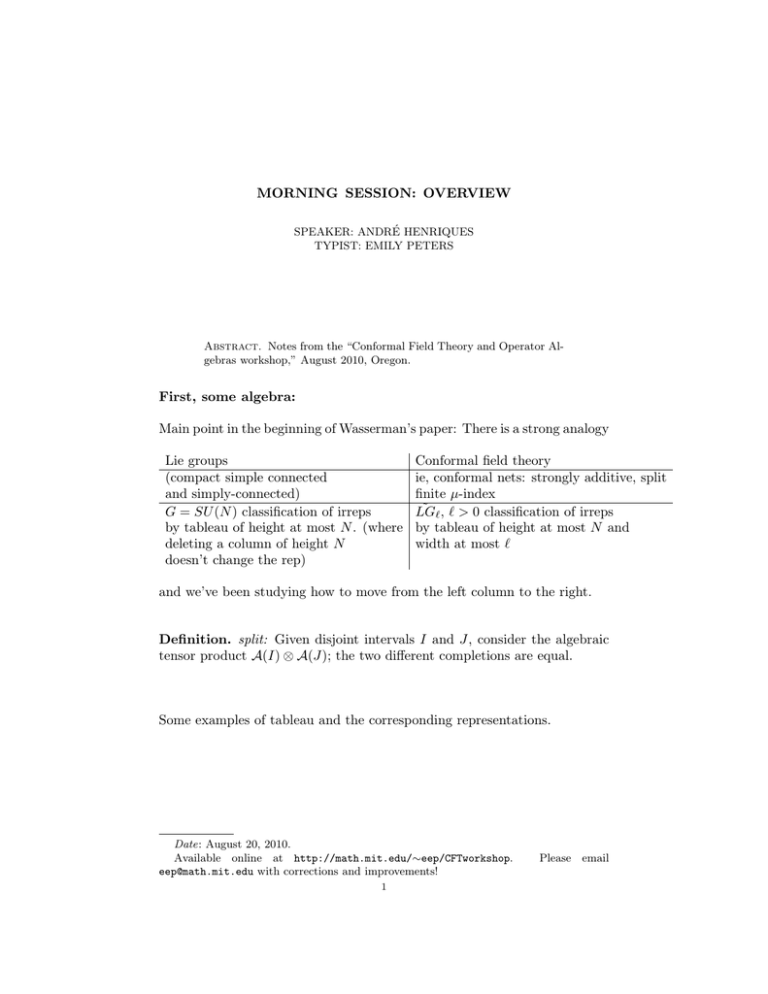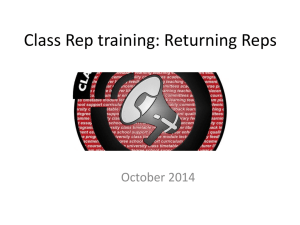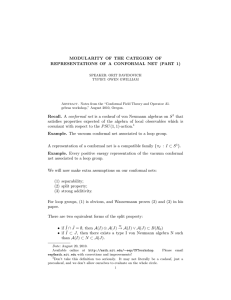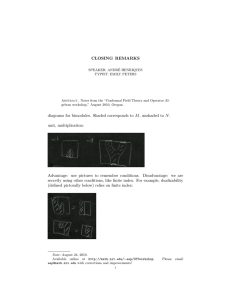MORNING SESSION: OVERVIEW
advertisement

MORNING SESSION: OVERVIEW SPEAKER: ANDRÉ HENRIQUES TYPIST: EMILY PETERS Abstract. Notes from the “Conformal Field Theory and Operator Algebras workshop,” August 2010, Oregon. First, some algebra: Main point in the beginning of Wasserman’s paper: There is a strong analogy Lie groups (compact simple connected and simply-connected) G = SU (N ) classification of irreps by tableau of height at most N . (where deleting a column of height N doesn’t change the rep) Conformal field theory ie, conformal nets: strongly additive, split finite µ-index ˜ ` , ` > 0 classification of irreps LG by tableau of height at most N and width at most ` and we’ve been studying how to move from the left column to the right. Definition. split: Given disjoint intervals I and J, consider the algebraic tensor product A(I) ⊗ A(J); the two different completions are equal. Some examples of tableau and the corresponding representations. Date: August 20, 2010. Available online at http://math.mit.edu/∼eep/CFTworkshop. eep@math.mit.edu with corrections and improvements! 1 Please email 2 SPEAKER: ANDRÉ HENRIQUES TYPIST: EMILY PETERS Piere rule: − ⊗ V[k] = add k boxes, no two in same row; sum over the corresponding irreducibles Vλ , with mutliplicity one. The goal is to show the very same statement, with addition of an admissibility condition f1 − fN ≤ ` on tableau: − H[k] = add k boxes, no two in same row; sum over the corresponding irreducibles Hλ , with mutliplicity one. Example. Here’s one difference between the two pictures: Free fermion rep has only one irrep while loop group has lots of them. ˜ on Fock space. We have an action of LG Notice that LG reps correspond Lgreps, which correspond to Lpol g reps, where we take the finite energy parts of the vector spaces and no longer have to worry about unbounded operators. This is very useful for classification MORNING SESSION: OVERVIEW 3 ˜ results. For example, an Lpol g rep gives us a rep of a dense subgroup of LG; pol so classification of L g reps gives us an upper bound on the number of LG ˜ on Fock space to actually construct these reps; then we use the action of LG reps. Virasoro algebra/ Dif f (S 1 ). There is also an analytic side to this story: The main technical tool for studying (type III) von Neumann algebras is Tomita-Takesaki theory. One can build noncommutative Lp spaces such that L∞ (M ) = M , L1 (M ) = M∗ (the predual), and L2 (M ) is some hilbert space – all of these are equalities as bimodules of M . Further if M = A( ) then L2 (M ) is the vacuum rep. The *-operator on L2 (M ), typically called J, acts via Is this breaking symmetry? No because we chose a special upper half circle already M = A( ). it −it with φ = h·Ω, Ωi; this acts We also have a modular flow ∆it φ (ξ) = φ ξφ via –this is a geometric implementation of the modular flow (along the lines of the Bisognano-Wichman theorem). We get factoriality because the modular group is ergodic, and that these factors are type III1 . Thus: free fermions are a factor representation. Being a factor represen˜ ` acting on H0 or tation tells us that the vNa we get by completing LI (G) ˜ ` acting on Hλ ; a priori it’s not clean at all why the two different LI (G) 4 SPEAKER: ANDRÉ HENRIQUES TYPIST: EMILY PETERS completions (LI ˜(G)` )00 should be the same; however, they both sit inside Fock space, and are both factor reps, so are canonically isomorphic. Thus we can talk about “the” level ` representation At this point we can talk about ”the” conformal net associated to the loop group. We can view these as bimodules for the algebra M , where we secretly identify the top and the bottom intervals via J; (Finite index condition means) We get a braided rigid ribbon category. Many of these properties follow from there being only finitely many Lpol g reps. Question. Can you say something about fusion of conformal nets coming from loop groups? Answer. Ah, so the question is, we have a rep of this style but also need to know, say, that the left interval acts. Solution: use the formalism Yoh used; ρ, σ ∈ End(A( near the boundary. ”Localized endomorphisms.” )) that act trivially Use that Hρ ' H0 equivariantly w.r.t. We also had talks about primary fields: Defined the beasts (Arturo classified them using algebraic approach, constructed them using fermions), Anatoly defined some function (four-point function) via power series, and we’ll need to know that the value of the function at a certain point in non-zero. This is why we calculated the transport coefficients.








